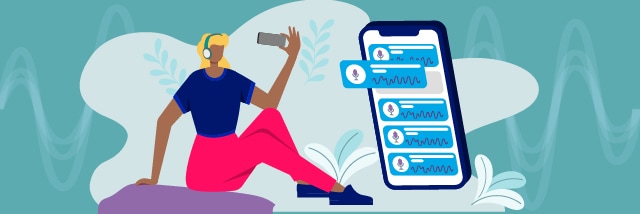What is a voice tag? This is a question that many aspiring musicians and producers have been asking themselves recently. But, they have been possibly the same question about bet tags, DJ drops, voice-overs, voice stamps, or producer tags.
Essentially, in current use, all these terms designate one thing. According to KrissLiss, voice tag and its alternative terms designate “a spoken phrase that advertises a brand identity or idea.” They are used “in the entertainment industry to watermark (or “tag”) music, promote brand recognition, and concisely relay messages to listeners.”
Also, according to Chelsea Voice Tags, they have a function of protecting productions/music from theft. In most cases, a voice tag goes over a specific beat or a music snippet. Such an audio clip usually lasts 5 to 9 seconds. Urban Dictionary also notes that “voice tags are NOT copyrightable because alone they do not meet the minimally creative standard needed for copyright protection.” To protect voice tags, artists and producers have to register them as trademarks.
Another area where voice tags are commonly used is in video production. There, use and technology are the same as in the music industry.
The thing that might catch the eye of entrepreneurs in other fields and industries could be that part of the voice tag definition. Its use to “advertise a brand identity or idea.” It seems that there is much more room to explore the voice tag. As Rain Agency notes, “brands have been seeking out the opportunity for voice-enabled advertising far before voice technology reached mass adoption.” Can voice tags find more extensive use in promoting a certain brand and ideas behind it?
Current use of voice tags in the music industry
A slew of copyright infringement suits within the music industry is a telling fact. Usually, it is not an easy task to prove copyright infringement in music. For beats that process is even harder. That is why the use of voice tags has become quite a common practice. This is particularly true with hip hop, rap, and electronic music artists.
AirBit, one of the companies that specialize in producing, promoting, and selling voice tags say that in many cases voice tag “most commonly consists of someone repeating the producers’ name every 20-30 seconds.” Still, artists are able to personalize their voice tags any way they see fit.
Once a voice tag is ready, when they upload a specific beat, the tags are added to it. From there on, the process of tagging all other productions is more or less automatic. Also, the tagging system then mixes and loops a voice tag with untagged music.
To make sure the process goes smoothly, the artist needs to leave about 20-30 seconds of silent audio after or before the actual voice tag.
Specialized music lyrics site Genius discussed recently how voice tags helped hip hop producers make a name for themselves. One such producer is Metro Boomin’. Jaye Neutron, the CEO and founder of VoiceTagGods.com told Genius that “the main reason Metro’s name is out there is because of his voice tag.”
One of his tags has Young Thug uttering “Metro Boomin want some more,” on hits like Offset’s “Ric Flair Drip.” Meanwhile his “If young Metro don’t trust you, I’m gon’ shoot you” tag is on the intro of Kanye West and Kid Cudi’s 2016 hit “Father Stretch My Hands Pt. 1.” Metro ingeniously wove the tag into the song. There, it serves as a crucial component of the opening drop” despite previously appearing elsewhere.

But what about the possible use elsewhere?
Back in 2011, Elana Zak, now a senior editor at CNN wrote for AdWeek that she came across a site that “lets you tag and share a 30-second audio clip. It was pretty neat. Within minutes of using the site, and without needing any new software or know-how, I recorded a clip wishing my little brother a happy birthday and posted it on Facebook.”
Even then, this was an indicator that the use of voice tags can go beyond the music and video industry. Their use for branding, promotion is yet to be fully explored. As Rain (above) points out
That “NPR was an early entrant on the content publishing side to meet this demand as they began selling these ads through their smartphone & in-vehicle apps to allow a user to respond when their screen went off or their hands were tied up.”
Also, they noted that “creative applications of voice ads continue to evolve.” They lend themselves to two-way interaction that can achieve a high level of captive attention by requiring the consumer’s verbal participation.
One of the areas, where the advertising voice tags can be very useful is with smart speakers. The leaders in this field are Amazon’s Alexa and Google Assistant. “Along with Pandora, other content providers like The Washington Post & Bloomberg continue to experiment with new ways to offer advertisers a platform on their smart speaker experiences.”
For its part, Spotify “announced the launch of voice ads that will promote content within the app, such as branded playlists.”
To back up their research Rain has come pout with some compelling numbers. Those numbers speak about the possibilities of voice advertising and voice tags that are still open.
Numbers always tell the story
The first report comes from Adobe. It says that 38% of consumers that have come across voice ads have found them to be less intrusive than traditional ads. Also, 39% of them believe the ads are more engaging. “A limited study from Instreamatic.ai, the partner behind Pandora’s voice ad program, found that voice ads were 10x more effective than others it ran through an online radio streaming service.”
eMarketer study from August 2018 found that “about 42% of their 1,079 respondents felt that digital ads are becoming “too aggressive.” They follow you from multiple devices and browsers.” Rain poses a key question. Will voice advertising be effective as an additive component of a campaign, or will consumers want it to replace traditional methods to avoid ad fatigue?
One direction they point to is that voice could also serve as a strong advertising medium during hard to reach moments. One such moment is commuting. “Early bets on personalized advertisement in the car are growing rapidly. AI startup Audioburst raised $10 million in April (2018) to focus on expanding advertising programs into vehicles.”
Another area that deserves detailed exploration is voice search. It just might prove that searching for a vocal snippet or a voice tag could prove more useful than say searching for a ‘full’ ad.
According to WebFX, in 2020, voice search will account for half of all searches. They stress the following points:
- Voice search will direct more focus to featured snippets;
- It will increase the value of Position Zero;
- Voice search will prioritize the semantics of searches;
- It will also maximize the value of artificial intelligence;
- Voice search will grow the mobile-friendly movement;
- It will build the value of local SEO;
- Voice search will make micro-moments a priority;
- It will become a digital marketing must.

Can voice tags find use as a promotional tool with voice assistants?
WordStream came up with a detailed study exploring the way in which voice assistants are impacting marketing strategy.
The first instance they note is the fact that voice assistants are emphasizing the Featured Snippet. This is something where a voice tag can present an interesting opportunity. “Voice assistants like Google Assistant frequently pull answers to voice queries from sites that are ranked in position zero for given queries. This makes getting a featured snippet a popular optimization tip for voice search.” (See the WebFX prediction above.)
The second fact is that voice assistants are yielding more web traffic. Matt Jones, SEO executive at online tutor platform Tutorful said that “Google Assistant will now tell users they can open the Google Home app to see more at the end of a verbal answer.”
Another factor they point to is that voice assistants are resulting in better content – and better stories. “Voice assistants have also been pushing brands to create new kinds of content.”
All this indicates that voice assistants are “driving new forms of advertising.” Robb Hecht, the adjunct marketing professor at Baruch College, calls voice assistants “the true first interactive tool in the home that provides brands the capability to dynamically offer up ads in the future that could be user controlled.”
At the same time, voice assistants also offer the potential for far more personalization for individual consumers. Also, among other points, voice assistants are better enabling retention. Marty Weintraub, the founder of Aimclear marketing agency, says “it’s fabulous for marketers to have the ability to inject retention and up-sell brand messaging with assistant information design to enhance customer service.”
This all adds up that “voice assistants are pushing products in new ways and enabling new experiences.”
Opportunities for imaginative use of voice tags
So the use of a voice tag in music and partially video industry has made its inroads. Not only for the protection of intellectual property but also for establishing a brand and presenting ideas.
At the moment, the use of voice tags for more detailed or sophisticated advertising is not there yet. The opportunities like its use in mobile situations like commuting, or with voice assistants are obviously there. It is up to the potential users of a voice tag technology to research all the possibilities. And as the examples above show the true opportunities are there.










